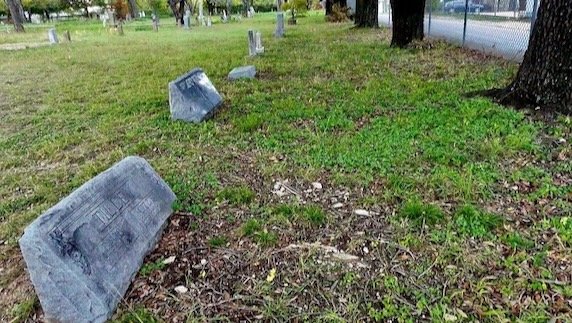
The Constellation of Living Memories is hosting its inaugural symposium on Dec. 2 in Dallas.
A Dallas-based nonprofit is hosting an event to encourage leaders across the state in conservation, education, public policy and community engagement to transform forgotten historic cemeteries into beautiful native landscapes, havens for cultural reverence and peaceful respite.
The Constellation of Living Memorials’ inaugural symposium is set for Dec. 2, 9 a.m. to 3 p.m. at Texas A&M Water and Land Resource Building at 17360 Coit Road in Dallas.
The event is intended to be an inspiring discussion with hands-on learning experiences and opportunities to network with a variety of experts in diverse fields, says Julie Fineman, president of Friends of the Warren Ferris Cemetery and founder of the Constellation of Living Memorials.
“This symposium is for anyone working at the intersection of public health, environmental stewardship, and community heritage — policy makers, researchers, students, neighborhood leaders, descendants, planners, preservationists, community organizers, and government partners. If you care about restoring abandoned cemeteries, strengthening neighborhoods, and transforming forgotten spaces into equitable, healthy urban green spaces, this gathering is for you,” Fineman says.

The symposium emerges from Fineman’s works as a Texas Master Naturalist who coordinated the transformation of the 19th-century Warren Ferris Cemetery near her home in Dallas into a native pocket prairie. The site is the burial grounds for some of Dallas’ most-prominent historic figures.
Working with neighbors and volunteers, Fineman cleared dense, non-native plants that had overtaken graves and began restoring the grounds to its original Blackland Prairie ecosystem.
That grassroots effort evolved into the Constellation of Living Memorials initiative, which launched in November 2023 with the goal of replicating this model across Texas and eventually throughout the nation.
Fineman says that Texas is home to an estimated 15,000 neglected historic cemeteries, many covered by invasive privet and exotic species. These spaces often become the sites of crime, dumping, and other unwanted activities – eyesores in neighborhoods and along rural roadways that fail to honor the memory of those buried within their boundaries.
Sometimes, the cemeteries are forgotten except for public records. In other cases, local volunteers struggle to obtain enough manpower or funds to simply mow weeds. Vandals also abuse the sites, requiring extensive research to locate burial spots and replace gravemarkers.
The Constellation approach transforms these historic cemeteries into landscapes featuring indigenous plants and pollinator-friendly species, which can lower long-term maintenance costs as well.
The initiative also addresses multiple urban challenges as restored cemeteries lower urban heat island effects, strengthen local pollinator populations, create wildlife corridors for migrating species, and provide green spaces in underserved neighborhoods.

The organization has repeated the transformation now in several additional historic cemeteries in the Dallas area, and the restored spaces also serve as outdoor classrooms where students learn about archaeology, botany, and local history.
The initiative partners with Texas A&M AgriLife Extension programs, including Texas Master Naturalists, Master Gardeners, and 4-H youth, along with organizations like the Native Plant Society of Texas, Preservation Dallas, and local neighborhood groups.
Restoration methods are tailored to each site's unique soil, tree canopy, topography and other natural and cultural needs.
At the December symposium, attendees will view Building Constellations, a short documentary chronicling the pilot program's first two years.
Panel discussions will explore how communities are reimagining these spaces, including a session titled Reimagining Historic Cemeteries: From Sacred Grounds to Community Spaces.
Collaborative sessions will bring together state and local leaders to discuss expanding the model statewide. Participants will tour the Texas A&M Water & Land Resources Building and connect with partners working on similar initiatives.

The Constellation of Living Memorials model demonstrates that historic cemeteries can serve dual purposes: preserving cultural heritage while creating habitats. Restored cemeteries feature butterflies among native flowers, birds nesting in heritage trees, and educational programming where children learn about local history and native plants, Fineman adds.
For gardeners, naturalists, preservationists, and those interested in public space development, the symposium will provide information on restoration methods and community organizing strategies. The event will present case studies from communities that are transforming these spaces into ecological sanctuaries and outdoor classrooms.
“We hope attendees gain a deep understanding of how abandoned cemeteries shape public health, environmental conditions, and neighborhood well-being — and leave equipped with practical strategies, collaborative models, and community-driven tools to protect these sites,” Fineman says. “Our goal is for participants to walk away inspired, connected and empowered to help revitalize neglected burial grounds into vibrant, resilient green spaces that honor the past while serving today’s communities.”
CONSTELLATION OF LIVING MEMORIALS SYMPOSIUM
ABOUT: Hosted by Constellation of Living Memorials, the symposium gathers thought leaders, practitioners, educators and philanthropists shaping the future of cemetery renewal across Texas. Learn how historic sites can be transformed into neighborhood green spaces, cultural preserves and wildlife refuges.
WHEN: Dec. 2, 2025, 9 a.m. to 3 p.m.
WHERE: Texas A&M Water and Land Resource Building at 17360 Coit Road in Dallas
TICKETS: Tickets for the event are $17.85 for students, $49.87 for members of partner organizations and $60.54 for the general public. The admission fee includes lunch and refreshments.
